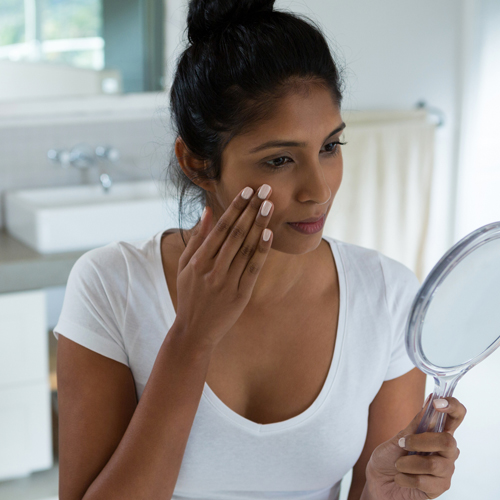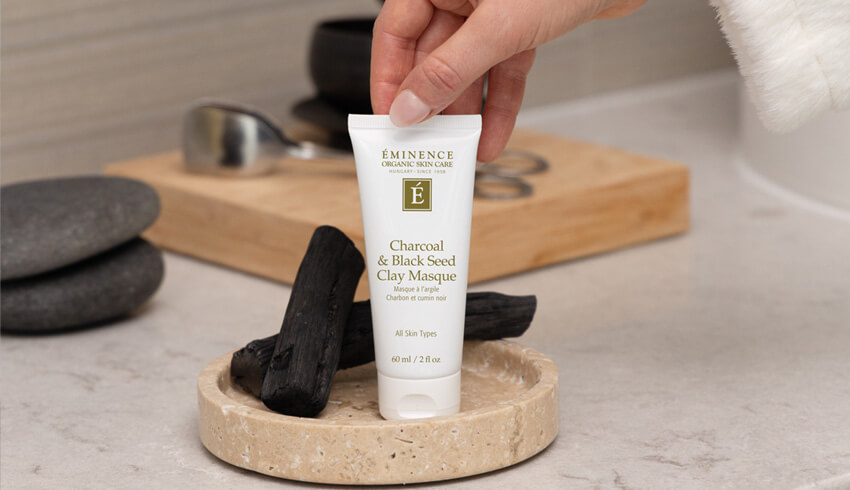
Is your skin dry in some areas and oily in others? Combination skin can be tricky to tackle and often feels like a balancing act. While there is no one-size-fits-all solution to this skin type, we have a few skin care tips and tricks to help you find a happy medium. Read on to learn more about your combination skin and how to manage it.
5 Signs That You Have Combination Skin: The Skin Test
Since combination skin and oily skin are similar, people often mix these skin types up. Here are five symptoms associated with combination skin. Is this you?
1. You Have Oily & Dry Skin Spots
To test whether you have combination skin, wash your face, leave it bare and wait one hour. Does your skin look and feel oily in your T-zone, but normal or dry on your cheeks and jawline? If so, you likely have combination skin. This skin type is exactly as it sounds - a combination of multiple skin types - and, as a result, you’ll experience both oily and dry patches on your complexion.
2. You Experience Mild Breakouts & Dryness at the Same Time
Clogged pores often equal breakouts. Due to excess oil production, combination skin often displays occasional and mild acne breakouts, particularly during hormonal fluctuations like monthly menstruation. These blemishes tend to concentrate in the T-zone, where oil glands are most active, while areas around the cheeks, jawline and hairline will still feel dry.
3. You Have Larger Pores on Your Nose, Chin & Forehead
Do you notice obviously large pores on your nose, chin and forehead? Combination skin is characterized by overactive oil glands in the T-zone. As a result, the nose, chin and forehead of combination skin are more prone to clogged pores. When sebum builds inside pores, they must expand to account for the excess oil, giving them an enlarged appearance. Luckily, they can shrink back to their normal size (more on this below).
4. Your Makeup Looks Patchy
Does your makeup slip off your T-zone and cling to your cheeks? Odds are, you’re dealing with a combination skin type. If your makeup is looking patchy by midday, the best fix is to optimize your skin care routine for your skin type.
5. Your Skin Gets Oilier in Summer & Drier in Winter
With combination skin, your oily-to-dry ratio tends to fluctuate with the seasons. During summer, heat and humidity cause sebum production to increase, causing the T-zone to feel extra oily and your dry spots to feel more “normal.” During winter, the opposite occurs: Environmental exposure sucks moisture from your skin and your T-zone will feel “normal” while your dry spots will feel drier. If you identify with this skin type and you’re concerned about why you have combination skin in the first place, read on to find out why (hint: blame your genetics).

What Is Combination Skin?
Combination skin refers to people with both dry and oily areas on the face, confirms Dr. Hooman Khorasani, Dermatologic and Cosmetic Surgeon. This skin type is characterized by non-uniform oil production: more active oil glands in the T-zone and less active oil glands elsewhere.“Typically the oily area is the T-zone, which goes across the forehead and down the bridge of the nose to the tip of the chin. This is where you'll find sebaceous glands on the face, as well as bigger pores, which cause this area to be more oily,” says Dr. Khorasani.
Watch this In The Mix video as Eminence Organics Lead Skin Care Trainer Natalie Pergar demonstrates three easy steps for categorizing your skin.
Dry Combination Skin Vs. Normal Combination Skin
Sometimes your symptoms might not fall neatly into the description listed above, which might leave you feeling confused as to whether you have combination skin. Well, you can further break down the categories into normal-combination skin and dry-combination skin. To recognize whether you have normal-combination skin, check whether you have an oily T-zone and that the skin on your cheeks feels ‘normal’. In other words, not dry. This is referred to as normal-combination skin. In comparison, if you have an oily T-zone but dry cheeks, you probably have dry-combination skin. With dry-combination skin, you may have a shiny forehead or chin, but dry cheeks.
What Causes Combination Skin?
Some potential causes of your combination skin include:
Genes
Like all skin types, combination skin is genetic. Generally, this skin type is characterized by non-uniform oil production: more active oil glands in the T-zone and less active oil glands elsewhere. Combination skin often features oily areas such as the forehead, nose and jaw with large pores, shine and blackheads. At the same time, the cheeks, jawline and hairline tend to be dry, showing flakiness, dullness and fine lines.
Hormonal Influences
Skin issues can be amplified by hormonal influences and environmental factors that exacerbate oily and dry skin symptoms. Your sebaceous glands (sebum) have receptors on them, which respond to your hormones, including testosterone and estrogen. The more testosterone that’s produced, the more oil is produced in the skin.
Environmental Factors
Another major factor is the environment when you’re dealing with the heat and humidity. According to Byrdie: “Prolonged humid conditions cause sweat glands to produce more sweat, leaving the skin moist and shiny, whereas, prolonged heat (low humidity), causes skin to dehydrate and increases sensitivity (because the water content of the epidermis tends to reflect the level of humidity around it).”
How To Treat Combination Skin
It’s important to understand your skin type so that we can choose the right products and skin care routine to take care of your combination skin. Here are some simple ways to improve combination skin.
Find the Best Products for Combination Skin
The goal for combination skin is to treat both oily and dry areas for a clear, balanced complexion. You can do so by using the right products. As Dr Khorasani explains, choose drying agents for the oily zones of our face (such as gels and lotions) and more hydrating products for the dry zones (such as oils and ointments).
Reduce Breakouts With a BHA
Use a BHA exfoliant on the oily, problem spots to unclog pores and bring new skin to the surface. In a similar vein, you can reduce excess oil with a cleanser with salicylic acid to help reduce oil build-up and clogged pores.
Use Blotting Paper
When you feel areas of your face becoming greasy, keep blotting sheets on hand. They will remove the shine and soak up any excess sebum. Avoid rubbing the paper vigorously on the skin as this might irritate and spread the oil around instead of absorbing it.
Treat the Dry Cheeks Vs Oily T-Zone Separately
Since your T-zone is typically greasy and other areas of your face are much drier, you want to treat each area with different products. Instead of applying the same moisturizer everywhere, use a lightweight moisturizer on your T-zone and a richer moisturizer on your cheeks for deeper hydration..
Do you have combination skin? Take a look at this skin care routine specifically designed for combination skin types. We’d love to hear how you tackle this tricky skin type. Share your thoughts with us in the comments below or on social media.


